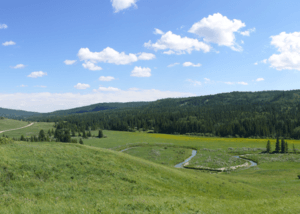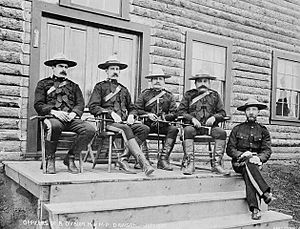Cypress Hills Massacre facts for kids
Quick facts for kids Cypress Hills Massacre |
|
|---|---|

Site of the Cypress Hills Massacre
|
|
| Location | Saskatchewan, Canada |
| Nearest city | Maple Creek No. 111 |
| Year of event | 1873 |
| Designated | 1 January 1964 |
The Cypress Hills Massacre occurred on June 1, 1873, near Battle Creek in the Cypress Hills region of Canada's North-West Territories (now in Saskatchewan). It involved a group of American bison hunters, American wolf hunters or "wolfers", American and Canadian whisky traders, Métis cargo haulers or "freighters", and a camp of Assiniboine people. Thirteen or more Assiniboine warriors and one wolfer died in the conflict. The Cypress Hills Massacre prompted the Canadian government to accelerate the recruitment and deployment of the newly formed North-West Mounted Police.
Contents
Aftermath
News of the Cypress Hills Massacre did not reach Ottawa until late August 1873, therefore the event itself was not very well known in Canada. The Canadian government soon took steps to have those involved extradited from the United States and tried for murder, causing confrontation between Canada and the United States. The case languished for some time and then was taken up by the newly created North-West Mounted Police (NWMP). The NWMP at this time was still establishing itself; the battle between the Assiniboine warriors and Hardwick's group of wolf-hunters at Cypress Hills was one of the catalysts for its creation.
Investigation and Trials
In December 1874, Assistant Commissioner James Macleod was given permission by the U.S. government to enter Helena, Montana Territory to start an investigation into the Cypress Hills Massacre. Depending upon the findings of this investigation, the accused could have faced extradition to Canada to face trial under Canadian law. Seven arrests were made, but two men escaped custody before they could be examined. The remaining men were freed because there was not enough clear evidence to prove anything against them, and the American commissioner refused the extradition request as there was far too much conflicting testimony. The Canadian Commissioner (Macleod) was subsequently charged with false arrest, but this charge was soon dropped.
In June, 1876, shortly after they were released from custody in the United States, two traders and a wolfer crossed the border into Canada and were subsequently arrested and put on trial in Winnipeg. The Crown's case against them failed, however, once again weakened by insufficient or contradictory evidence. The three men were acquitted, and the case was finally dropped in 1882.
W. E. Cullen, the American commissioner, said at the extradition hearing at Helena: although the "preponderance of testimony is to the effect that the Indians commenced the firing... they were doubtlessly provoked to this by the apparently hostile attitudes of the whites... An armed party menacing their camp, no matter for what purpose, was by no means slight provocations."
Creation of the North-West Mounted Police
It is very difficult to measure the impact that the Cypress Hills Massacre had on Canada and the United States. The creation of the North-West Mounted Police (NWMP, later the Royal Canadian Mounted Police), was introduced partially as a result of the massacre. Around this time, the Lieutenant Governor of Manitoba, Alexander Morris, was concerned about perceived threats of violence to uniformed Canadians and Americans conducting geological surveys. As a result, Morris had to call off any further surveying until there was a solution. Unable to find a solution, Morris used the reports of the massacre to call on the Prime Minister of Canada, Sir John A. Macdonald, to create a police force. Already planning to establish a police force in the North-West Territories, Macdonald had envisioned a horse mounted brigade based on the idea of the Royal Irish Constabulary. The force would be small; only 300 men could enlist. For an area that covered 480 000 square kilometres, the force would have to be as mobile as possible. Alexander Campbell, the minister of the interior, did not believe sending an armed police force into the North-West Territories was necessary at this time, causing Morris to fear that any delay in training and deployment could be exacerbated further once winter fell. To force their creation, Morris claimed that the Métis and white settlers in the area around Portage la Prairie and Fort Qu'Appelle were experiencing fear and unrest due to the massacre. On September 25, 1873, the government of Canada passed an order-in-council to appoint nine officers of "Mounted Police Force for the North-West Territories". Recruitment began immediately, and the North-West Mounted Police was created. With the new police force patrolling the area, the border could no longer be so easily crossed.
The creation of the police force also had a political motive. The investigation into the massacre was to ensure that First Nations in the area were able to trust the Canadian government. The investigation would require international cooperation of two federal governments, and the North-West Mounted Police would take measures to make examples out of international criminals. Although ultimately no prosecution took place, the willingness to seek justice for any Canadian contributed to the establishment of peace between the NWMP and First Nations.
As time went on the Cypress Hills Massacre gradually became part of popular knowledge about Canada's past even though the event was never fully closed and dealt with.
Images for kids



